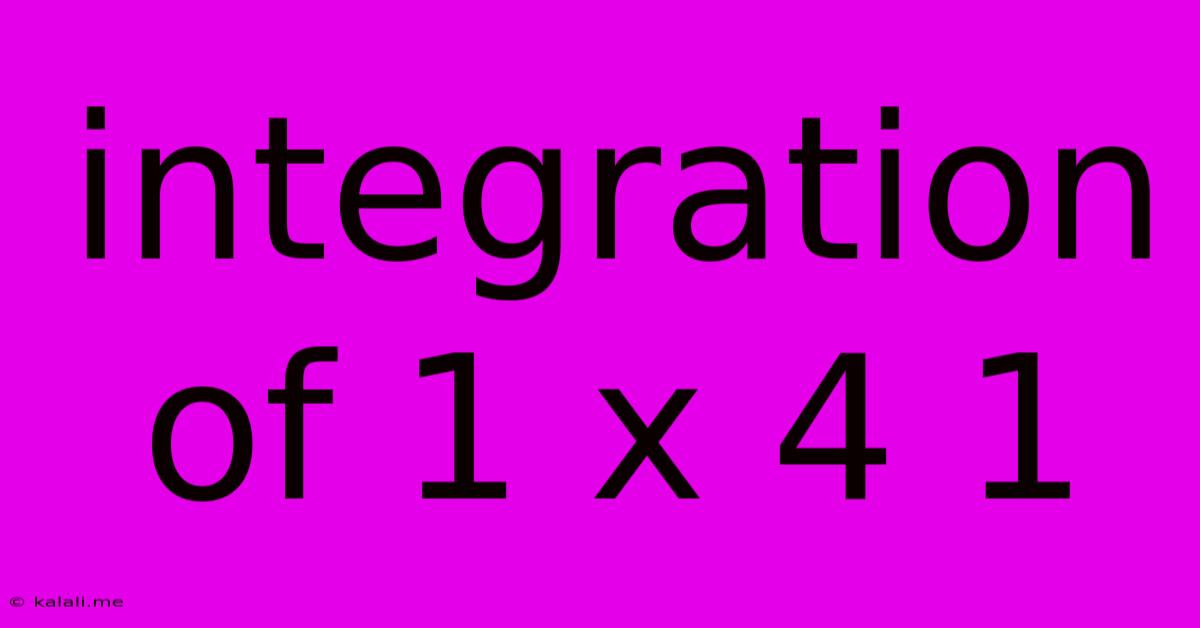Integration Of 1 X 4 1
Kalali
May 23, 2025 · 3 min read

Table of Contents
Understanding the 1x4 Optical Splitter: Integration and Applications
This article delves into the world of 1x4 optical splitters, exploring their integration into various systems and highlighting their numerous applications. A 1x4 optical splitter, a fundamental component in fiber optic communication networks, divides a single optical input signal into four identical output signals. This technology plays a crucial role in expanding network capacity and enabling efficient signal distribution. Understanding its integration is key to leveraging its potential.
What is a 1x4 Optical Splitter?
At its core, a 1x4 optical splitter is a passive optical device that employs the principles of light division to distribute a single optical signal across four output channels. This division maintains the signal's integrity, ensuring that each output receives an identical copy of the original signal, although with reduced power. This power reduction is predictable and depends on the splitter's design. The split ratio, in this case 1:4, means the input power is divided evenly amongst the four outputs.
Types of 1x4 Optical Splitters:
Several types of 1x4 optical splitters exist, each with its own advantages and disadvantages. These include:
-
PLC (Planar Lightwave Circuit) Splitters: Known for their small size, low insertion loss, and excellent performance stability, PLC splitters are widely used in various applications. They offer good uniformity and are highly reliable.
-
Fused Biconic Tapered (FBT) Splitters: These are more cost-effective than PLC splitters, but they generally have slightly higher insertion loss and less precise splitting ratios. They are a viable option for applications where budget is a primary concern.
-
Arrayed Waveguide Gratings (AWGs): AWGs provide high performance and precise wavelength division multiplexing capabilities. However, they are typically more expensive and less widely used for simple 1x4 splitting applications.
Integration into Fiber Optic Networks:
The integration of 1x4 optical splitters into fiber optic networks is straightforward. They are typically connected using fiber optic connectors (like SC, LC, or FC) at both the input and output ports. This allows seamless integration with other optical components, such as optical transceivers, fiber optic cables, and other passive components. Proper fiber management and connector cleanliness are crucial for maintaining optimal performance. Understanding the fiber type and its compatibility with the splitter is vital for successful integration.
Applications of 1x4 Optical Splitters:
1x4 optical splitters find applications across diverse fields:
-
FTTH (Fiber to the Home) Networks: Distributing broadband internet access to multiple homes from a single fiber line.
-
CATV (Cable Television) Networks: Distributing television signals to multiple households.
-
PON (Passive Optical Network) Systems: Providing connectivity to multiple users in a cost-effective manner.
-
Security Systems: Enabling the distribution of video surveillance signals across multiple monitoring points.
-
Wireless Network Infrastructure: Feeding multiple base stations in wireless communication systems.
-
Sensor Networks: Facilitating the transmission of data from multiple sensors to a central control unit.
Choosing the Right 1x4 Optical Splitter:
The selection of an appropriate 1x4 optical splitter depends on several factors:
-
Wavelength: Ensure the splitter is compatible with the wavelength of your optical signal.
-
Insertion Loss: Lower insertion loss means less signal degradation.
-
Return Loss: This indicates the amount of reflected light, impacting signal quality.
-
Polarization Dependent Loss (PDL): Low PDL is essential for minimizing signal distortion.
-
Operating Temperature Range: Consider the environmental conditions where the splitter will be deployed.
By carefully considering these factors, you can choose a 1x4 optical splitter that optimizes your network's performance and reliability. The versatility and cost-effectiveness of 1x4 optical splitters make them an integral part of modern fiber optic communication networks, driving advancements in various fields.
Latest Posts
Latest Posts
-
How To View Messages On Icloud
May 23, 2025
-
Business In The Front Party In The Back
May 23, 2025
-
How Long Does Polyurethane Take To Dry
May 23, 2025
-
How To Clean A Shower Drain
May 23, 2025
-
Linux How To Unzip A Zip File
May 23, 2025
Related Post
Thank you for visiting our website which covers about Integration Of 1 X 4 1 . We hope the information provided has been useful to you. Feel free to contact us if you have any questions or need further assistance. See you next time and don't miss to bookmark.